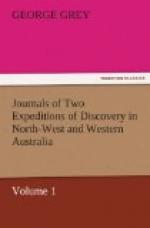We were unfortunate in not catching a turtle during the night; the season for them had however now passed away, so that we could only hope to cut off a stray one which might have lingered behind its fellows. The next day was occupied in sticking up a steer-oar with a tin canister attached to it, containing a letter in which was detailed the plan I intended to follow, so that in the event of any accident occurring, and our remaining on the coast, we might still have the chance of a vessel being sent to search for us. The men were occupied in looking for shellfish, drying the flour, and preparing the boats. It blew nearly a gale of wind from the south throughout the day.
RETURN TO THE MAIN.
March 22.
This day at two P.M., all our preparations having been completed and the wind somewhat moderated, we stood across the bay, and soon after nightfall made the main about twelve miles to the north of the northern mouth of the Gascoyne. The wind freshened a great deal during the night; but as it was impossible to beach boats on so dangerous a coast in the dark we were obliged to trust to the goodness of our anchors, and they did not disappoint us.
March 23.
Before dawn this morning we were under weigh and pulling dead to windward against a strong breeze and heavy sea; the men rowed almost without intermission until noon when, finding them completely exhausted, I made sail and stood in towards the shore. When we had approached the land about four miles to the north of the Gascoyne a party of natives came down, without their spears, in the most friendly manner, making signs to us to land. We had however but little time to spare, and could not afford to give them any provisions: knowing also the small dependence that can be placed upon them in a first interview, I thought it most prudent to decline their invitation.
COMPLETE OUR WATER.
We accordingly continued our route and in the course of the evening made the river, where we completed our water, and halted for the night. We saw nothing more of the natives here, but I feel convinced that in the event of a settlement being formed at this point no difficulty would be found in establishing and maintaining the most friendly relations with them.
ANCHOR TO THE NORTH OF THE GASCOYNE.
March 24.
The morning did not promise very well, but soon after sunrise the wind shifted so much to the westward that we were able to run along shore, and in the course of the day we made altogether about forty-five miles, tracing the greater part of the remaining unknown portion of the shores of Shark Bay. On leaving the Gascoyne, a low point bore due south of us, distant about twelve miles, which I named Point Greenough after George Bellas Greenough, Esquire, the president of the Royal Geographical Society; and between this point and the river lay a deep bay, the shores of which were low and thickly studded with mangroves, through which many saltwater creeks ran up into the country. Two of these creeks I had examined on a previous occasion, and therefore now paid no attention to them.




